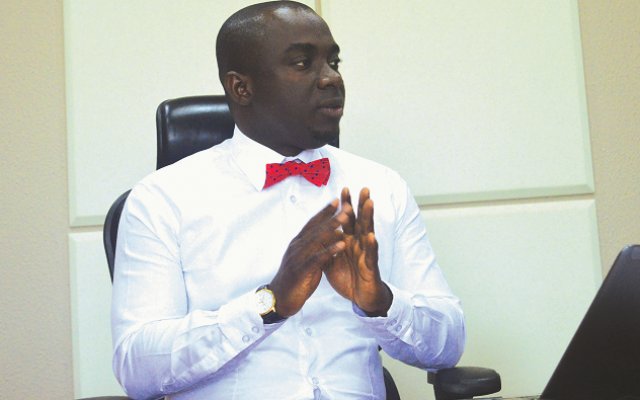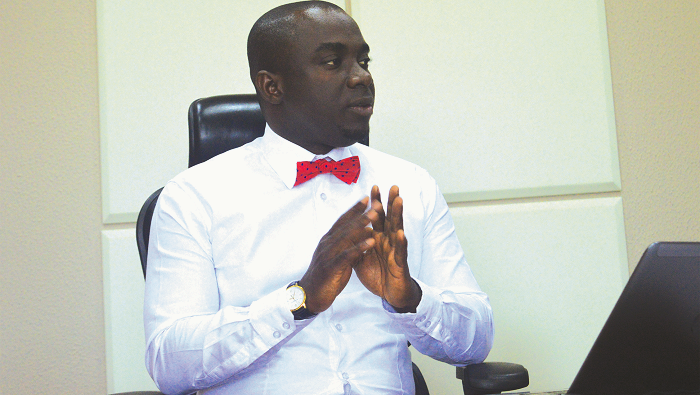
Former Branch Chief Executive (BCE) of the Tema Community (1) branch of the defunct Beige Bank has told the High Court that, the allegation that the funds were moved from the customer’s accounts at the instructions of Michael Nyinaku, without the consent of the affected customers is false.
According to him, none of the over 10,000 customers whose funds were allegedly siphoned is on record as having lodged a complaint at the time the funds were moved from their account raises significant doubt about the substance of the allegation.
Mr Harold Mensah, the 6th Defense Witness for the former Chief Executive of the defunct bank made this known to the High Court presided over by Justice Afia Serwah Asare-Botwe during his Evidence-in-Chief.
Mr. Nyinaku, the founder and Chief Executive Officer of the defunct bank has been charged for allegedly stealing GH¢2.1 billion of depositors’ money from the bank.
He has since pleaded not guilty to 43 charges including stealing, fraudulent breach of trust and money laundering, and has been granted bail.
Testifying as the 6th Defense Witness for Michael Nyinaku’s, the former Branch Chief Executive also said, that none of these customers is “on record as having lodged complaint at the time the funds were moved from their account raises a significant doubt about the substance of the allegation.”
“Finally, that none of the 10,000 plus customers is on record as having rejected the investment certificate issued to them following the purported unauthorized movement of funds from their account raises significant doubt about the substance of the allegation,” he told Justice Afia Serwah Asare-Botwe, a Justice of the Court of Appeal.
He told the Court that, it is not a normal banking practice for anyone who is not a signatory to an account to cause funds to be moved from that account.
“By the way the internal departments of the bank were structured, the accused as CEO was not at all involved in banking operations,” he told the Court.
The Witness said, “I have assumed scenarios by which the allegation against the accused could be executed assuming they were to have happened at all, and all of the scenarios that I have only posited were simply not probable let alone possible.”
“As a matter of fact, during my stay at the bank, none of these scenarios has ever been reported to have occurred.
“As a branch manager of the bank for a period long before it was put under receivership, I am deeply familiar with the internal processes of the bank as well as the happenings within the bank where they concern branch management and banking operations.
With particular reference to the testimony of Mr. Julies Ayivor, the first Prosecution’s Witness where he referred to customer deposits being transferred from their fixed deposit account without the customer’s consent.
He said that explanation is contradictory, “this is because there is a world of difference between current accounts on the one hand and fixed deposits on the other.”
“With FDs, once they are booked they cannot be moved. This is because, on the very elementary understanding of the FD, all it means is that the customer has decided to lock the funds and will not deal with such funds over a period.
“For this reason, the funds would already have been debited to the customer’s account at the time when the FDs were booked. Thus, an FD already booked cannot be moved again. Thus, the fact that an already established FD cannot be moved makes this assertion inaccurate as the same cannot happen,” he added.
The Witness told the Court that, in the case of current account deposits, to say ‘funds have been moved from a customer’s account without their consent,’ “simply means the customer did not intend to have the funds moved in the first place.”
“Thus, in simple terms, the movement was unauthorized in which case the funds must be brought back or as we say in banking, the transaction must be reversed,” he stated.
“The allegation that current account deposits of 10,000plus customers were moved from their account and credited to BCAM at the instruction of the accused is totally impossible and cannot be true. I make this statement because as a BCE I have had sufficient training in banking and therefore I understand the rudiments of banking.
“The first reason why I say this allegation cannot be true or possible is based on the simple fact that this act does not happen in the practice of banking or even in banking law. In banking practice, bank accounts are operated by bank mandates. When accounts are opened, the owners of the accounts specify mandates signatories] to the accounts, and the bank requests for specimen signatures of these signatories. It is only the person who has been appointed and documented as a signatory to a specific account that can authorize transactions to occur on that account.
“The second reason why I say this allegation cannot be true or possible is based on the practicality of the allegation.
“As I earlier explained, at TBB [and in the practice of banking] every single transaction that occurs on a customer’s account must be originated by a transaction advice which advice must be signed by the signatory to the account.
“Before the bank processes this transaction it would have cross-checked the signature on the advice to ensure that it matches with the specimen signature of the account holder in the bank’s system. It is also known that transactions can only be effected on a customer’s account at the instruction of the customer,” he explained.
Scenarios
The former Branch Chief Executive said, to say that “the accused instructed for funds to be moved from the current accounts of customers is to suggest that any or a combination of the following scenarios is what could have taken place
a. Scenario 1 will be where the accused hacked the banking system and inserted his image in the system for over 10,000 plus customers. This would be to make sure that when the operations officers are verifying any customer instruction they would see his image and assume it is him.
b. Scenario 2 will be where the accused having placed his image in the system for over 10,000 plus customers then signed over 10,000 different specimen signatures and caused all of these different specimen signatures to be uploaded into the banking software to serve as a match to his photos which have dubiously been configured into the system. This would ensure that when the operations officers were verifying any customer instruction, they would see that the signature and photos were •a match.
c. Scenario 3 will be where the accused forged the signatures of over 10,000 plus customers and for each of these customers, he presented transaction advice to the bank which transaction advice authorized the movement of the funds. This transaction advice would have been presented to several branches of the bank nationwide. This scenario further assumes that on every occasion when each of this 10,000plus transaction advice with forged signatures was presented at the several branches of the bank, the operations officers in conducting their verification and validation of each of the 10,000plus transaction advice were unable to detect that the signatures of the original account holders had been forged.
d. Scenario 4 will be where the accused actually issued express instructions by email or memo to the banking operations team and specifically directed them to debit the accounts of specific customers with various sums. I say this because at Beige most communication was done by email or memos and an action as strange, unusual, and sensitive as the one being alleged, cannot be authorized verbally. I say this again because it is only the banking operations team that has the capacity and responsibility to process transactions into customers’ accounts therefore if the accused wants any such action [as has been alleged] to be done, it is the banking operations team that he would have to issue instructions to. Now, considering that the transactions are alleged to have happened over a period of 19months [February 2017- July 2018] and also on different dates then this scenario assumes that the accused must have issued over 10,000 of such different emails or memos to the banking operations team to serve as instructions for what he requires them to do. Even if there were not 10,000 plus of such directives from the CEO, there would be a lot of them that would be attached to a list of customers, their account numbers, amounts that should be debited from their accounts, and the dates on which these debits should be executed.
The case has been adjourned to May 24, 2024, for Prosecution to subject the Witness to scrutiny.
Find attached the full Witness Statement of DW6
Source: Ghana/Starrfm.com.gh/Murtala Inusah



